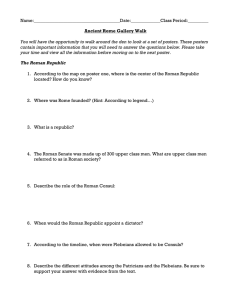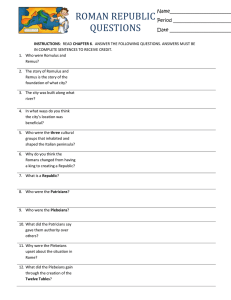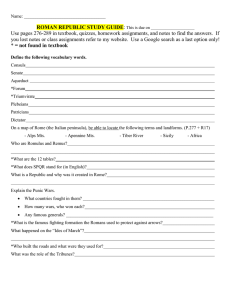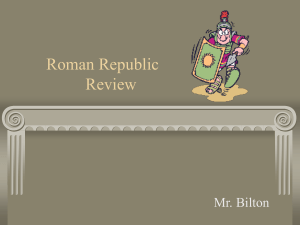1/15 and 1/19 • 1. Pick up the papers by the door.
advertisement
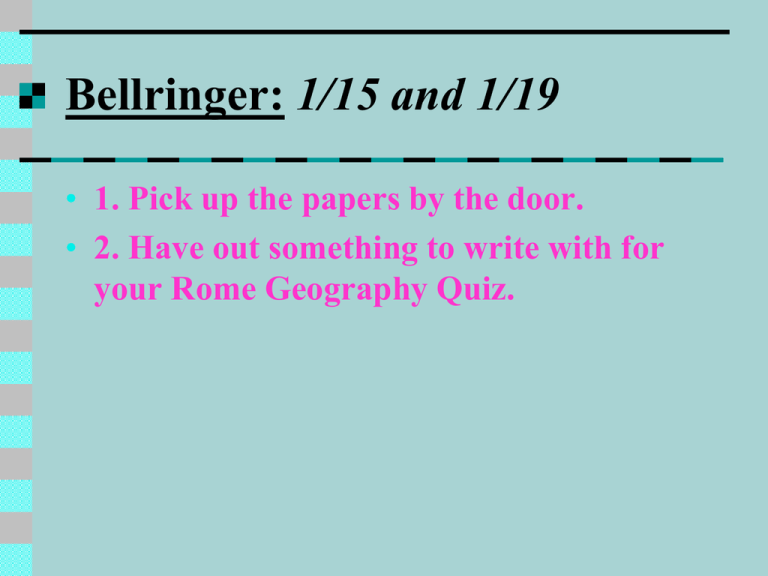
Bellringer: 1/15 and 1/19 • 1. Pick up the papers by the door. • 2. Have out something to write with for your Rome Geography Quiz. After your quiz: • 1. Make the following Table of Contents updates: • • • • • Page 81: Rome Geo. Quiz Page 82: Notes: Roman Republic Page 83: Questions: Roman Law/12 Tables Page 84: Reading: Struggle for Polit. Power in Rome Page 85: Reading Qs: Struggle for Political Power in Rome Agenda: 1/15 and 1/18 • • • • 1. Bellringer: Quiz Review 2. Quiz: Roman Geography 3. Notes: Roman Republic 4. Reading/Questions: Roman Law and the 12 Tables (3rd and 8th only, not 5th) • 5. Begin on homework: • Reading/RQs: Struggle for Political Power in Rome Homework: 1/15 and 1/19 • Complete Reading/Reading Questions: The Struggle for Political Power in Ancient Rome Roman Republic, Day 1 The Founding of the Roman Republic: • Legend of Romulus and Remus • Twin brothers, founders of Rome in 753 BCE • Historic background: • Etruscans are conquered by the Romans and established the Roman Republic • Patricians vs. Plebeians division • Patricians = upper class • Plebeians = common people Geography: • Plains, hills, & mountains, seas = natural barriers • Geography promotes unification in Rome • Means a centralized government, NOT citystates • Rome itself = well positioned • In the center of Mediterranean good spot for an empire Religion: • Gods same as Greeks • Example of cultural diffusion • Juno, Jupiter, and Minerva – BIG 3 • Job = provision over the people • Religious festivals/cults (i.e. Saturnalia) • Pontifex Maximus – religious leader in Rome Achievements: • Legal code • Laws stressed fairness, common sense • U.S. concept of justice, due process – get from Rome • Art • Sculpture (Classical-style) and mosaics • Architecture = influenced by Etruscans and Greeks • Roads, aqueducts for transportation • Stadiums and amphitheatre (from Greeks, Etruscans) • Arches (from Etruscans) Achievements: • Strong military - All male citizens = required to serve (during republic, changed under empire) - Military service required to serve in government - Military units called legions (cavalry, infantry) Clip: Roman Military Politics/Political Systems: • Political organization of Rome: • Centralized government, NOT city-states • Established a republic first, later an empire • Republic = government where people elect representatives • Same as in the U.S. • Rome = ruled by Senate, Consuls, the people • SPQR: “The Senate and the People” Politics/Political Systems: • 1. Senate (300 members, patricians) • Offered legal advice • Appointed consuls • Passed legislation (think 12 Tables) • 2. Consuls (power of “imperium”) • Year term • Involved in running the government, dealt with foreign affairs, military • Praetors = in charge when consuls are away, justice official Politics/Political Systems: • 3. The people (plebeians) • Organized by tribes • Elected 10 tribunes, who governed local affairs • Concilium plebis – legislative body for plebeians • Could pass laws, try cases, etc. • Other assemblies: Centuriate Economics: • An agricultural economy, supplemented by trade • Lots of arable land can grow their own food (makes them different from Greece) • Rome needs to trade • Makes them establish colonies throughout Mediterranean to trade (location makes this work) Social: • Citizens’ rights – fundamental aspect of Roman society • Felt a duty to participate in government • Voting = crucial right in Rome (makes you a citizen) • Stoicism – be rational, not emotional in your responsibilities Social: • Important values: fides, pietas, and virtus (fidelity, piety, virtue) • Client-patron system • Reciprocal relationships (“I scratch your back, you scratch mine.”) • Reflects the central Roman value of fidelity Social: • Roman family: • Patriarchal (men have the power) • Women = some rights (divorce, get husband’s property) but CAN’T VOTE! • Public vs. private spheres = gender roles are strict • Slavery in Rome • Military conquests slaves • Slaves = ~35-40% of the population Reading: Roman Law and the Twelve Tables • Read the excerpt provided. This is both a secondary and a primary source on Roman law and legal codes. • When finished, answer the questions. HW: Struggle for Political Power in Ancient Rome • Read the short reading provided on the fight for political power in Rome. • When finished, begin working on the reading questions. This will be a homework grade. Roman Republic, Day 2 Bellringer: 1/20 and 1/21 • 1. Identify the Roman god/goddess associated with the following: • • • • • • The moon, the hunt Doorways, beginnings/endings The sea Marriage, fertility Love and beauty War Agenda: 1/20 and 1/21 • 1. Bellringer: Roman Gods/Goddesses Review (or Project Evaluation for 3rd?) • 2. DBQ Practice – Roman Republic vs. U.S. Government • 3. Essay Practice – Writing an Introductory Statement and a Thesis Statement Homework: 1/20 and 1/21 • 1. Write an introductory paragraph and thesis sentence for the prompt provided. • 2. Read pages 146-147 in your CLASS TEXTBOOK (not AP packet) Quick Recap: Roman Republic • Review Questions Writing Practice: DBQ: THE ROMAN REPUBLIC AND THE UNITED STATES DBQ Practice: • With a partner, analyze the documents provided in the DBQ packet. • We will review these together when everyone is finished. Writing an Introductory Sentence: Writing an Introductory Sentence: Good vs. Bad Ones What do I include in an introductory paragraph? Good vs. Bad Intro. Paragraphs Thesis Statement: What is it? Good vs. Bad Thesis Statements

